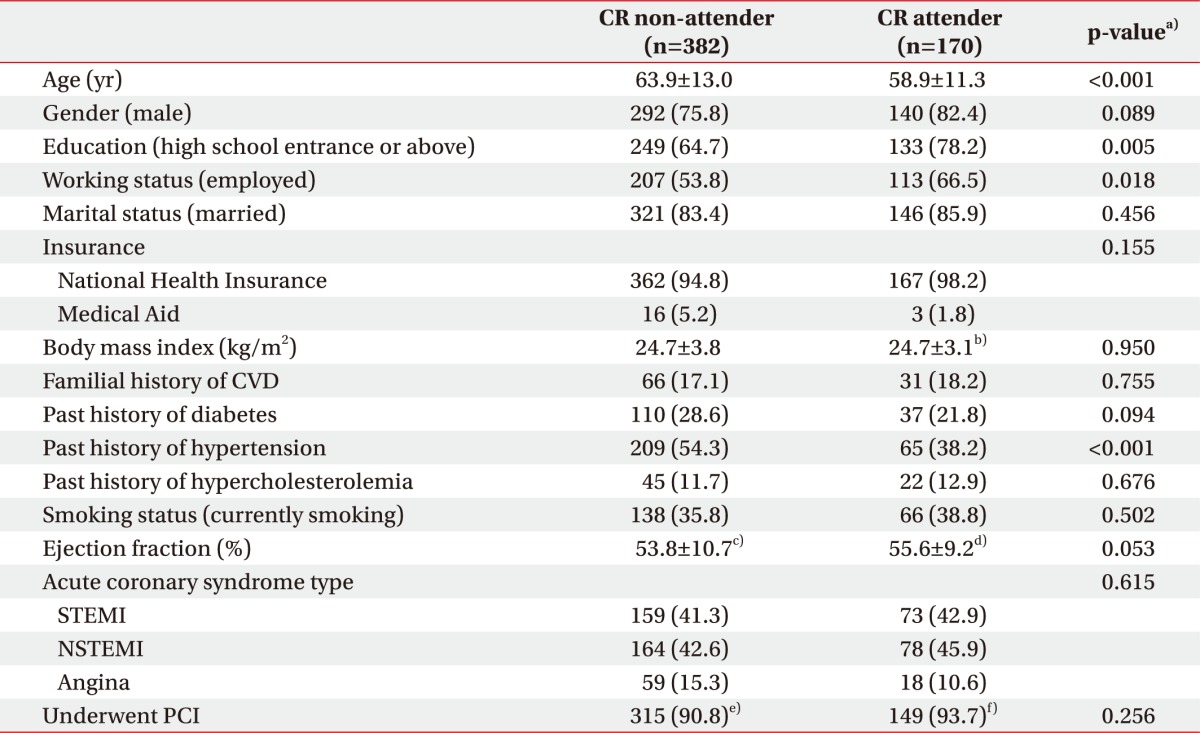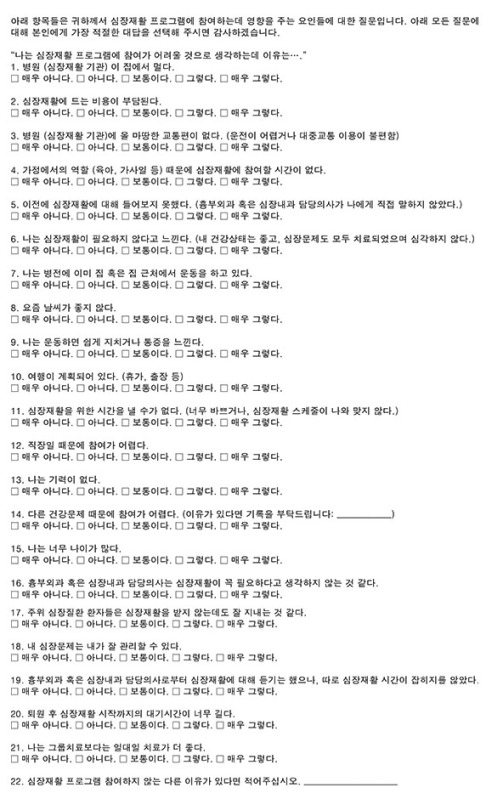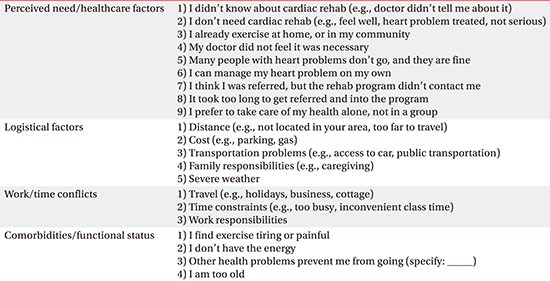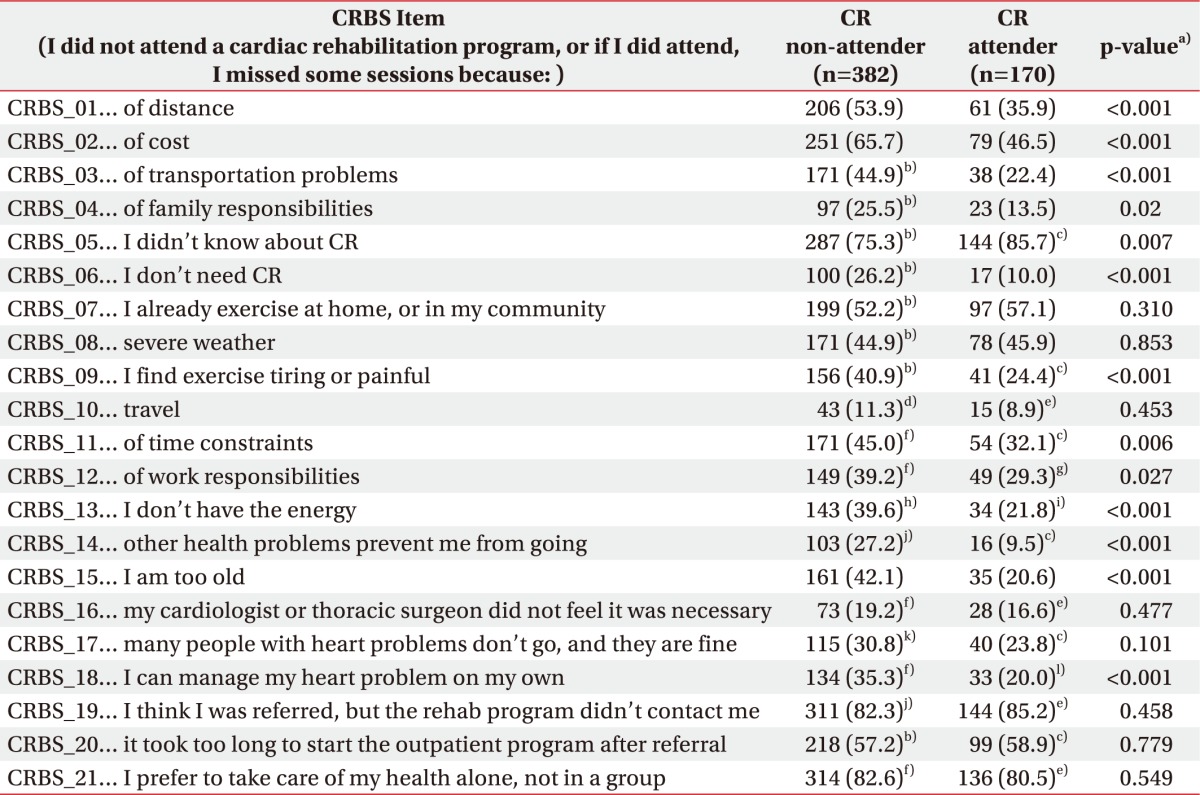1. Anderson L, Oldridge N, Thompson DR, Zwisler AD, Rees K, Martin N, et al. Exercise-based cardiac rehabilitation for coronary heart disease: Cochrane systematic review and meta-analysis. J Am Coll Cardiol 2016;67:1-12. PMID:
26764059.


2. Smith SC Jr, Benjamin EJ, Bonow RO, Braun LT, Creager MA, Franklin BA, et al. AHA/ACCF secondary prevention and risk reduction therapy for patients with coronary and other atherosclerotic vascular disease: 2011 update: a guideline from the American Heart Association and American College of Cardiology Foundation. Circulation 2011;124:2458-2473. PMID:
22052934.


3. American Association of Cardiovascular and Pulmonary Rehabilitation. American College of Cardiology Foundation. American Heart Association Task Force on Performance Measures (Writing Committee to Develop Clinical Performance Measures for Cardiac Rehabilitation). Thomas RJ, King M, Lui K, et al. AACVPR/ACCF/AHA 2010 update: performance measures on cardiac rehabilitation for referral to cardiac rehabilitation/secondary prevention services endorsed by the American College of Chest Physicians, the American College of Sports Medicine, the American Physical Therapy Association, the Canadian Association of Cardiac Rehabilitation, the Clinical Exercise Physiology Association, the European Association for Cardiovascular Prevention and Rehabilitation, the Inter-American Heart Foundation, the National Association of Clinical Nurse Specialists, the Preventive Cardiovascular Nurses Association, and the Society of Thoracic Surgeons. J Am Coll Cardiol 2010;56:1159-1167. PMID:
20863958.


4. Balady GJ, Williams MA, Ades PA, Bittner V, Comoss P, Foody JM, et al. Core components of cardiac rehabilitation/ secondary prevention programs: 2007 update: a scientific statement from the American Heart Association Exercise, Cardiac Rehabilitation, and Prevention Committee, the Council on Clinical Cardiology; the Councils on Cardiovascular Nursing, Epidemiology and Prevention, and Nutrition, Physical Activity, and Metabolism; and the American Association of Cardiovascular and Pulmonary Rehabilitation. Circulation 2007;115:2675-2682. PMID:
17513578.


5. Dalal HM, Doherty P, Taylor RS. Cardiac rehabilitation. BMJ 2015;351:h5000PMID:
26419744.



6. Clark RA, Conway A, Poulsen V, Keech W, Tirimacco R, Tideman P. Alternative models of cardiac rehabilitation: a systematic review. Eur J Prev Cardiol 2015;22:35-74. PMID:
23943649.


7. Dalal HM, Taylor RS. Telehealth technologies could improve suboptimal rates of participation in cardiac rehabilitation. Heart 2016;102:1155-1156. PMID:
27067360.


8. Endo N, Goto A, Suzuki T, Matsuda S, Yasumura S. Factors associated with enrollment and adherence in outpatient cardiac rehabilitation in Japan. J Cardiopulm Rehabil Prev 2015;35:186-192. PMID:
25622218.


9. Cooper AF, Jackson G, Weinman J, Horne R. Factors associated with cardiac rehabilitation attendance: a systematic review of the literature. Clin Rehabil 2002;16:541-552. PMID:
12194625.


10. Kim C, Lim HS, Ahn JK, Bang IK, Lee SM, Kim YJ. The reasons that cardiac patients did not participate in and drop out from the cardiac rehabilitation program. J Korean Acad Rehabil Med 2002;26:790-796.
11. Baek S, Park HW, Lee Y, Grace SL, Kim WS. Translation, cross-cultural adaptation and psychometric validation of the Korean-Language Cardiac Rehabilitation Barriers Scale (CRBS-K). Ann Rehabil Med 2017;41:858-867. PMID:
29201826.



12. Shanmugasegaram S, Gagliese L, Oh P, Stewart DE, Brister SJ, Chan V, et al. Psychometric validation of the cardiac rehabilitation barriers scale. Clin Rehabil 2012;26:152-164. PMID:
21937522.



13. Dunlay SM, Witt BJ, Allison TG, Hayes SN, Weston SA, Koepsell E, et al. Barriers to participation in cardiac rehabilitation. Am Heart J 2009;158:852-859. PMID:
19853708.



14. Grace SL, Gravely-Witte S, Kayaniyil S, Brual J, Suskin N, Stewart DE. A multisite examination of sex differences in cardiac rehabilitation barriers by participation status. J Womens Health (Larchmt) 2009;18:209-216. PMID:
19183092.



15. Shanmugasegaram S, Oh P, Reid RD, McCumber T, Grace SL. Cardiac rehabilitation barriers by rurality and socioeconomic status: a cross-sectional study. Int J Equity Health 2013;12:72PMID:
23985017.



16. de Melo Ghisi GL, Oh P, Benetti M, Grace SL. Barriers to cardiac rehabilitation use in Canada versus Brazil. J Cardiopulm Rehabil Prev 2013;33:173-179. PMID:
23635836.


17. Babu AS, Veluswamy SK. Barriers to cardiac rehabilitation in India. J Prev Cardiol 2016;5:871-876.
18. Chamosa S, Alarcon JA, Dorronsoro M, Madruga FJ, Barrera J, Arrazola X, et al. Predictors of Enrollment in Cardiac Rehabilitation Programs in Spain. J Cardiopulm Rehabil Prev 2015;35:255-262. PMID:
26110624.


19. Harlan WR 3rd, Sandler SA, Lee KL, Lam LC, Mark DB. Importance of baseline functional and socioeconomic factors for participation in cardiac rehabilitation. Am J Cardiol 1995;76:36-39. PMID:
7793400.


20. Statistics Korea. Operation by province and type of medical institution (general hospital) in Korea. Daejeon: Statistics Korea; 2015.
21. National Clinical Guideline Centre. MI-secondary prevention: secondary prevention in primary and secondary care for patients following a myocardial infarction: partial update of NICE CG48. London: Royal College of Physicians; 2013.
22. Buckingham SA, Taylor RS, Jolly K, Zawada A, Dean SG, Cowie A, et al. Home-based versus centre-based cardiac rehabilitation: abridged Cochrane systematic review and meta-analysis. Open Heart 2016;3:e000463. PMID:
27738516.



23. Audelin MC, Savage PD, Ades PA. Exercise-based cardiac rehabilitation for very old patients (≥75 years): focus on physical function. J Cardiopulm Rehabil Prev 2008;28:163-173. PMID:
18496314.


24. Perez-Terzic CM. Exercise in cardiovascular diseases. PM R 2012;4:867-873. PMID:
23174552.


26. Pack QR, Mansour M, Barboza JS, Hibner BA, Mahan MG, Ehrman JK, et al. An early appointment to outpatient cardiac rehabilitation at hospital discharge improves attendance at orientation: a randomized, single-blind, controlled trial. Circulation 2013;127:349-355. PMID:
23250992.


27. Balady GJ, Ades PA, Bittner VA, Franklin BA, Gordon NF, Thomas RJ, et al. Referral, enrollment, and delivery of cardiac rehabilitation/secondary prevention programs at clinical centers and beyond: a presidential advisory from the American Heart Association. Circulation 2011;124:2951-2960. PMID:
22082676.


28. Carnethon M, Whitsel LP, Franklin BA, Kris-Etherton P, Milani R, Pratt CA, et al. Worksite wellness programs for cardiovascular disease prevention: a policy statement from the American Heart Association. Circulation 2009;120:1725-1741. PMID:
19794121.


29. French DP, Cooper A, Weinman J. Illness perceptions predict attendance at cardiac rehabilitation following acute myocardial infarction: a systematic review with meta-analysis. J Psychosom Res 2006;61:757-767. PMID:
17141663.


30. Conraads VM, Deaton C, Piotrowicz E, Santaularia N, Tierney S, Piepoli MF, et al. Adherence of heart failure patients to exercise: barriers and possible solutions: a position statement of the Study Group on Exercise Training in Heart Failure of the Heart Failure Association of the European Society of Cardiology. Eur J Heart Fail 2012;14:451-458. PMID:
22499542.














